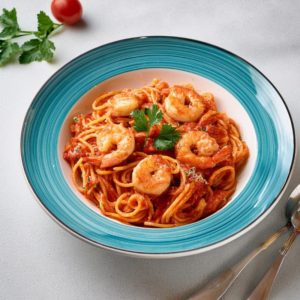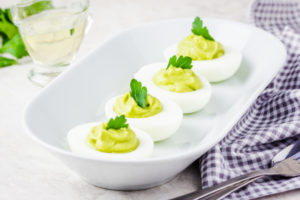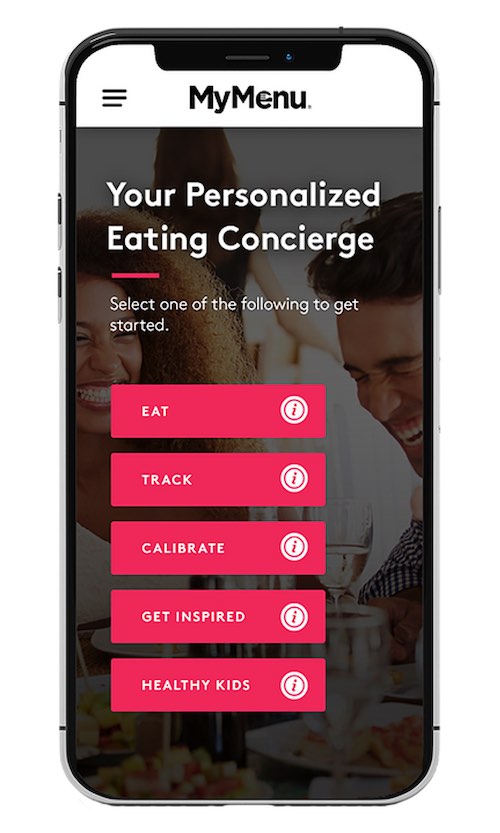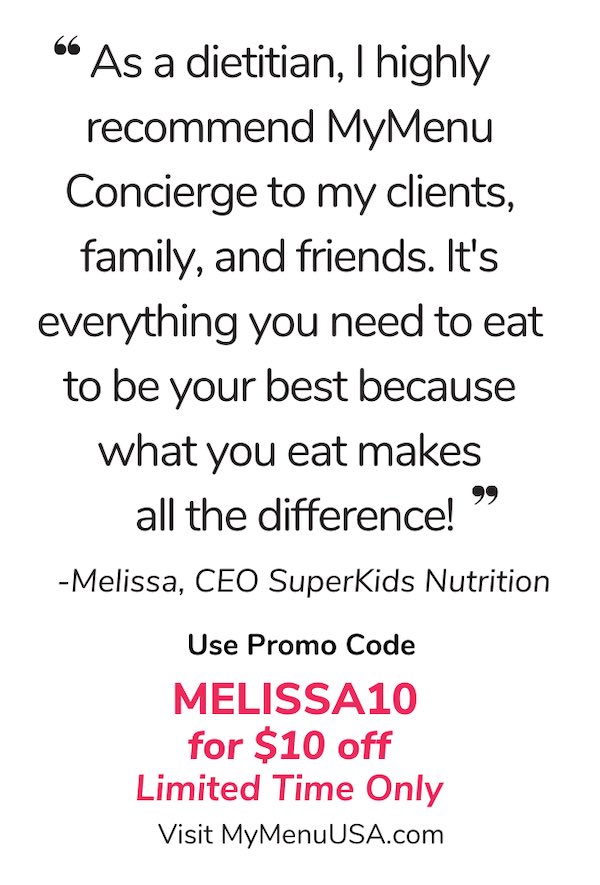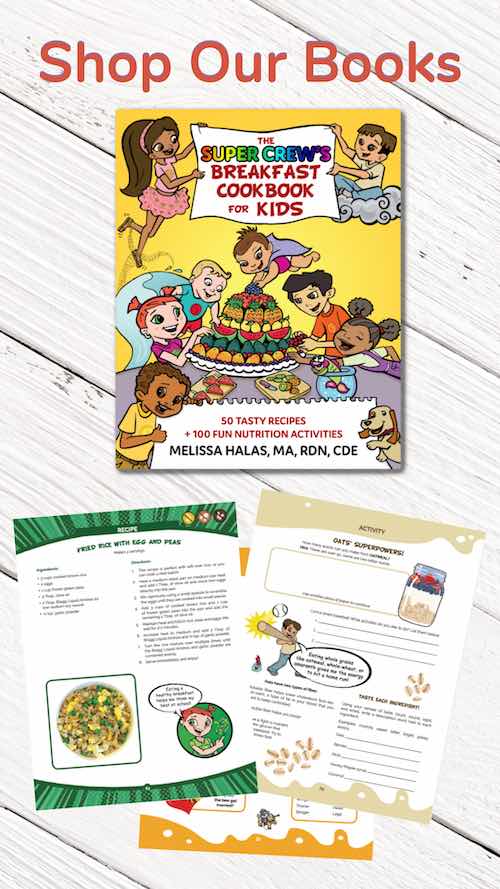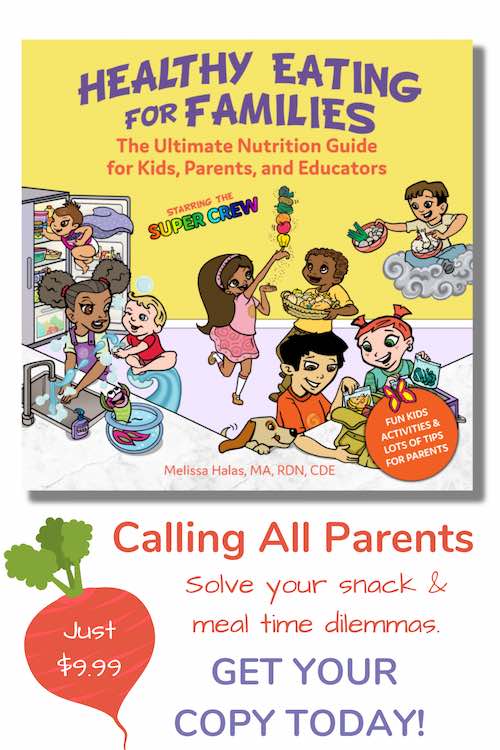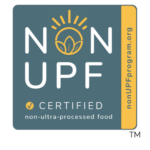
Looking for a simple but healthy meal plan for kids? Try these menus for creative yet easy options for a quickly growing 7-8-year-old!
By this age, kids’ activity levels can vary widely. You may have a quiet reader, a sports fanatic, or someone in between. You’ve also probably noticed that appetite varies as growth spurts come and go. Weren’t your son’s pants long last week?!
Either way, by adjusting to hunger and focusing on a healthy, high-quality, and varied diet, you’ll keep your child fueled for all their busy activities. Don’t be afraid to try new things. It’s never too early (or too late) to expand your child’s palate with new flavors and foods. Start by trying this colorful, healthy meal plan for kids.
Portion Size Targets in Healthy Meal Plan for Kids
For reference, keep these daily targets in mind! If you’re curious how these portion sizes change for different ages and genders, take a look at Food Portion Sizes for Toddlers, Kids, and Teens, according to MyPlate.
- Protein: 4 oz. equivalents
- Fruit: 1-1.5 servings
- Vegetables: 1.5 servings
- Grains: 5 oz. equivalents
- Dairy: 2.5 servings
- Oils: 4 tsp.
Key Nutrients for 7-8-Year-Olds
The Dietary Guidelines for Americans identify Calcium, Potassium, Dietary Fiber, and Vitamin D as nutrients of concern for Americans of all ages. (1) To make sure your family gets enough of these essential nutrients, offer a wide variety of foods in rainbow colors. This will help make sure you are getting all the different vitamins, minerals, and phytonutrients found in different colored foods. We have also identified some of the best food sources of the key nutrients here.
- Calcium: Dairy like yogurt, kefir, and cheese. Calcium-fortified dairy alternatives like soy milk and tofu. (2)
- Potassium: Dried fruits like apricots, prunes, and raisins. Legumes like lentils and kidney beans. Fruits and vegetables like bananas, winter squash, and potatoes. (3)
- Dietary Fiber: Whole grains like popcorn, oat bran, whole wheat bread, and crackers. All fruits and vegetables, legumes, and berries are especially high in fiber. (1)
- Vitamin D: Fish like trout, salmon, and sardines. Eggs and fortified dairy and nondairy products. (4)
If your family regularly eats many of these foods, great job. If not, see if you can find easy ways to start including a few in your meals. Remember, small changes can have a big impact on your health and your children’s health.
Hydration for 7-8-Year-Olds
When choosing drinks to go with meals, water and low-fat milk (or milk alternatives) are the best picks! Many other drinks, even those marketed as “healthy,” like sports drinks and juices, may be loaded with added sugars and dyes. Sticking with water and milk most of the time helps support your child’s growth and overall health!
For most kids, plain water is the best way to stay hydrated after playing sports or running around outside. For a competitive child athlete, lost electrolytes can naturally be replaced by eating a mid-game or post-game snack that includes sources of potassium, sodium, and magnesium. Sports drinks aren’t usually necessary unless your child is doing high-intensity sports in very hot weather or at high altitudes. Usually, these drinks have more sodium and sugar than kids need. So, keep it simple with water, and let nutritious snacks or meals do the rest! (5)
If your children clamor for sweet drinks, 100% fruit juice can be ok as a treat, but they’ll get more health benefits from eating whole fruits. Try making your own exciting drinks by adding frozen fruit or mint leaves to your water bottle. Consider enjoying some hydrating ice pops after a long game.
Healthy Meal Plan for Kids: Day 1
Breakfast: Smoothie

For a quick and easy breakfast, a smoothie is a great option! You can make a smoothie a balanced meal by adding a source of protein and dairy or dairy alternatives like Greek yogurt, milk, or soy milk. Try out this recipe for a tasty Spinach Banana Avocado smoothie your little one is sure to love!
Snack #1: Apple Slices with Nut or Seed Butter
For a quick and nutritious snack, toss apple slices in lemon, lime, or orange juice to prevent browning. Then, reassemble the apple, using a small serving of nut or seed butter as “glue” to hold it together—adding both flavor and lasting energy.
Lunch: Falafel Veggie Hummus Mix n’ Match
Make your own “Lunchable” by slicing your child’s favorite veggies and serving with a hummus dip! Pair the veggies and hummus with whole grain crackers or pretzels and round out the meal with a source of protein. We think that falafel would go great with this meal, but boiled eggs or sliced turkey would also do the trick.
Snack #2: Energy Bites
If you frequently find yourself on the go after school, energy bites can make a great car snack! Try my recipe for pumpkin chocolate chip energy bites, or plant-based bites.
Dinner: Turkey Sweet Potato Chili
Turkey Chili is a great way to get plenty of vegetables and legumes into your family! Sweet potato or butternut squash melts into a chili beautifully without altering the flavor too much and complements the beans perfectly. Include other vegetables like bell peppers, carrots, or corn to maximize this meal. For a vegetarian version, substitute ground tofu for the turkey, or just enjoy a bean chili.
Dessert: Chocolate Chia Seed Pudding
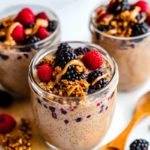
This tasty chia pudding is a great healthy dessert option. Serve with a fruit like blueberry or raspberry for extra flavor.
Healthy Meal Plan for Kids: Day 2
Breakfast: Baked Oatmeal Muffins
Baking oatmeal in a muffin tin is a great way to meal prep for breakfast! Top with your favorite fruits, nuts, and seeds, and serve with yogurt or nut butter in the morning.
Snack #1: Popcorn and Cheese
Did you know that popcorn is a whole-grain food? Make your own to customize this tasty treat without ultra-processed additives and food dyes found in many microwaved popcorn options. Serve with cheese for a source of protein and fat.
One year, my mom put a popcorn maker in my Easter basket, along with a variety of colorful corn. I think that’s why it’s still a staple in my diet today. You can also make popcorn on the stovetop—just heat a little olive oil in a large pot over medium heat, add the kernels, cover with a lid, and give it an occasional shake. Once the popping slows down, remove it from the heat and enjoy!
Check out my 10 favorite popcorn bar ideas that are full of flavor.
Lunch: Black Bean Quesadilla
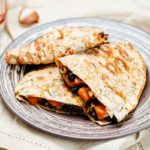
Nutritious lunches don’t have to be hard work! This tasty bean quesadilla is nutritious and filling without taking a lot of time to prepare.
Snack #2: Guacamole Deviled Eggs
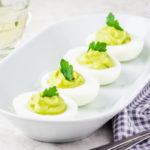
For a fun twist on deviled eggs, substitute avocado for your mayonnaise! Serve these devilled eggs with whole grain crackers and a fruit or vegetable of choice.
Dinner: Walnut and Panko Crispy Cod Fillets
For a dinner that has incredible taste and texture your family is sure to love, try my Walnut and Panko Crispy Cod Fillets! Serve this recipe with a vegetable, like sauteed green beans, and a source of whole grain to make this a complete meal.
Dessert: Purple Sweet Potato Donut Holes
For a healthier version of dessert, try these tasty purple sweet potato donut holes! This fun dessert is a sweet treat that is plant-based and gluten-free.
Healthy Meal Plan for Kids: Day 3
Breakfast: Banana And Granola Parfait
With sliced bananas and a sprinkle of healthy, unprocessed granola, yogurt becomes a quick and easy breakfast!
Snack #1: Almond Butter English Muffin
If your child is especially active and needs a little more energy, opt for the added fruit! A healthy meal plan for kids involves balanced meals and snacks.
Ingredients:
- ½ Whole-wheat English Muffin
- 1 Tbsp. almond butter
- ¼ cup raisins (optional)
Directions:
- Toast English muffin.
- Top with 1 Tbsp. Almond butter.
- Add ¼ cup of raisins or other dried fruit to the muffin or serve on the side.
Lunch: Hummus Sandwich With Veggies
Whole wheat bread, hummus, and vegetables make for a tasty sandwich! If your child enjoys sliced turkey or cheese, you could add a slice for a little extra protein since hummus is mostly a source of healthy fat.
Snack #2: Jicama Sticks and Dip
Jicama is a crunchy and tasty snack option. Serve with guacamole or your child’s favorite dip to add flavor and fun!
Dinner: Red Sauce Pasta with Shrimp and Zucchini
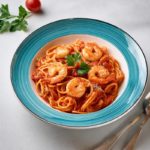
This dinner features shrimp as a source of lean protein! It’s packed with nutritious vegetables and whole-grain pasta for fiber.
Dessert: Frozen Fruit
Frozen fruit is a great option if your child craves something sweet after a meal! Grapes, mangoes, or blueberries are naturally sweet and great for dessert. They’re also delicious blended into a sorbet and topped with crushed nuts or cocoa nibs. If your child is still really hungry, serve the fruit with yogurt to make it more filling.
Healthy Meal Plan for Kids: Tips and Tricks
We hope these meal plans inspire you with healthy meal and snack ideas for your family! But these aren’t the only healthy meal and snack options out there! Get creative and build your own using these guidelines:
- Offer variety: Switch up the fruits and vegetables you offer to get your family used to different tastes and textures. There are so many delicious fruits, vegetables, and whole grains. After all, variety is the spice of life! (6)
- Make good nutrition easy and limit processed foods: Keep healthy snacks like fruits, vegetables, nuts, and yogurt without ultra-processed additives and dyes on hand for easy snacking. This can help prevent your children from filling up on ultra-processed foods of lower nutritional value. (6)
- Get the kids involved: Bring your children to the grocery store to help you shop for healthy snacks and ingredients. Get them involved in meal planning and age-appropriate meal prep! This can help them feel more connected to the food they eat. (6)
- Eat family meals: Family meals are a great way to connect over food! You can also be a good role model for your children and start discussions about the foods you’re eating. Eating as a family can also help you avoid eating in front of a screen, making it easy to focus on the food and each other. (6)
- Make meals fun: Try to eat the rainbow as a family or choose a new and exciting recipe together! Get curious about new ingredients and flavors. For more ideas, check out the Super Crew Activities! (6)
If you have concerns about your family’s eating habits, book an appointment with me today. Together, we find easy solutions to build a healthier foundation over time. Take charge of your family’s health and kickstart some results in the first six weeks: Book Pediatric Nutrition Counseling Today.
This article has been updated from its original publish date in August 2019.

